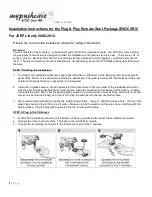
The driver's preferred units can be selected through the instrument panel settings if
equipped. Refer to “Understanding Your Instrument Panel” in your Owner’s Manual on
www.dodge.com/en/owners/manuals for further details. The speed decrement shown is
dependant on the chosen speed unit of U.S. (mph) or Metric (km/h):
U.S. Speed (mph)
• Pushing the SET
(-)
button once will result in a 1 mph decrease in set speed. Each
subsequent tap of the button results in a decrease of 1 mph.
• If the button is continually pushed, the set speed will continue to decrease until the
button is released, then the new set speed will be established.
Metric Speed (km/h)
• Pushing the SET
(-)
button once will result in a 1 km/h decrease in set speed. Each
subsequent tap of the button results in a decrease of 1 km/h.
• If the button is continually pushed, the set speed will continue to decrease until the
button is released, then the new set speed will be established.
To Accelerate For Passing
Press the accelerator as you would normally. When the pedal is released, the vehicle will
return to the set speed.
Using Speed Control On Hills
The transmission may downshift on hills to maintain the vehicle set speed.
NOTE:
The Speed Control system maintains speed up and down hills. A slight speed change on
moderate hills is normal.
On steep hills, a greater speed loss or gain may occur, it may be preferable to drive without
Speed Control.
WARNING!
Speed Control can be dangerous where the system cannot maintain a constant speed.
Your vehicle could go too fast for the conditions, and you could lose control and have
an accident. Do not use Speed Control in heavy traffic or on roads that are winding, icy,
snow-covered or slippery.
O P E R A T I N G Y O U R V E H I C L E
80
Summary of Contents for DURANGO 2017
Page 281: ...NOTES 279...
Page 282: ...NOTES 280...
















































